It has not been uncommon for the ungulates of the mountains of Europe to travel from distant regions, where significant climatic events such as Ice Ages have driven them to the extensive mountain areas of our continent in successive waves, generally from the East. In the mouflon’s case, it was not the species itself but mankind that was responsible for the journey; the mouflon arrived in Sardinia around 6,000 B.C. from the Middle East, brought by people from the East migrating westwards, who were already conversant with pastoral farming and pottery making. The area of origin has been identified on the basis both of the mouflon’s resemblance to the wild sheep of the area (the urial from the Caucasus and Turkey) and of the similarity in cultures between the invaders and the people of those areas. The mouflon did not end its travels on this big Mediterranean island; after spending may centuries in Sardinia - where numbers became widespread in the wild – and subsequently in Corsica, the species was brought to the mainland and introduced to the Italian peninsula and many other countries in Europe and beyond, starting in 1,790-92 with the first attempt to establish it in the northern Apennines. The furthest (and most inhospitable) place to which the mouflons were exported was the Kerguelen archipelago, off the Antarctic continent.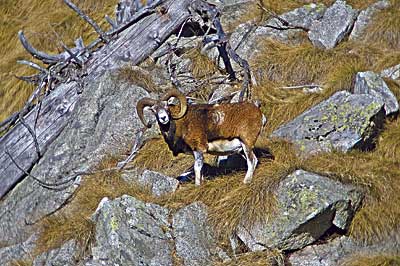
Currently in Italy, the spread of the species is fairly diverse; in its “historical” area of origin, Sardinia, there are around 6,000, located in Ogliastra, Mount Gennargentu, Mount Supramonte and Mount Albo, where herds have existed since their introduction, as well as in areas such as Pabarile, Capo Figari, and Asinara, where they have been reintroduced. The breed was then introduced to the smaller islands such as Elba, Capraia and Marettimo, extensive hillside areas in central Italy, the Apennines and the Alps.
The mouflon arrived in the Adamello Brenta Park between 1974 and 1976 and following further intakes, three colonies were created that still exist today, the largest in southern Brenta with more than 150 animals, one on the Presanella massif with around fifty and lastly a small group on the spurs of Val di Nardis.
The mouflon is a wild sheep of more slender appearance than the domestic variety, with horns usually seen only on the males; among the Sardinian mouflons, thinner and smaller horns can exceptionally be seen on females too while, on Corsica, 70% of the females have them. The horns have a compressed spiral shape and are dark brown in colour with a number of raised rings running across them, which may be worn away as a result of the knocks they suffer during fights between the males in the mating season.
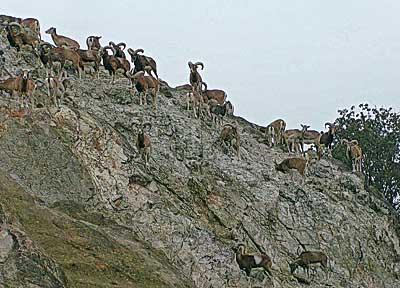 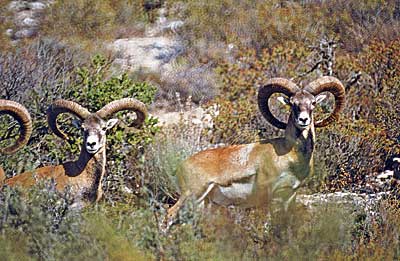 Annual growth is substantial up to 5 years of age and reduces considerably after that. The coat is coarse and short and is shed twice, in autumn and winter. It is chestnut in colour with lighter shades in Summer and darker ones in Winter; there is a white mark called a “saddle” on the backs of the adult males in Winter and a black mane down to the neck and chest. Annual growth is substantial up to 5 years of age and reduces considerably after that. The coat is coarse and short and is shed twice, in autumn and winter. It is chestnut in colour with lighter shades in Summer and darker ones in Winter; there is a white mark called a “saddle” on the backs of the adult males in Winter and a black mane down to the neck and chest.
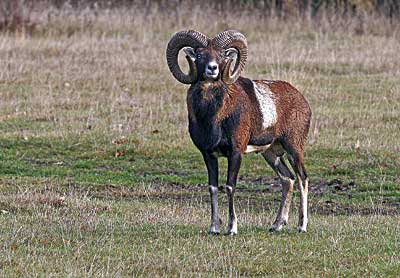 The mouflon is typical of Mediterranean areas and, in this region, it is associated with habitats that are rocky, at least in part; in fact, as for all mountain ungulates, the rocks represent an area of refuge that enable the mouflons to escape their predators. The altitudes they inhabit in the places they come from are very diverse, ranging from sea level to 1,300 – 1,600 metres above. The breed has shown itself able to withstand the worst of the winter climate in the Mediterranean area; it stays at altitudes of 1,300 – 1,500 metres above sea level on Supramonte even during the Winter. In mainland Italy, both in the Apennines and the Alps, it was introduced at altitudes of between 300 and 2,500 metres, with seasonal migration, sometimes substantial in the Alpine areas, depending on snowfall. Here, the mouflon is found in deciduous or mixed woods but also, in late Spring and Summer, on the upland meadows. The association with rocky hillsides, at every possible altitude, however, remains. The mouflon is typical of Mediterranean areas and, in this region, it is associated with habitats that are rocky, at least in part; in fact, as for all mountain ungulates, the rocks represent an area of refuge that enable the mouflons to escape their predators. The altitudes they inhabit in the places they come from are very diverse, ranging from sea level to 1,300 – 1,600 metres above. The breed has shown itself able to withstand the worst of the winter climate in the Mediterranean area; it stays at altitudes of 1,300 – 1,500 metres above sea level on Supramonte even during the Winter. In mainland Italy, both in the Apennines and the Alps, it was introduced at altitudes of between 300 and 2,500 metres, with seasonal migration, sometimes substantial in the Alpine areas, depending on snowfall. Here, the mouflon is found in deciduous or mixed woods but also, in late Spring and Summer, on the upland meadows. The association with rocky hillsides, at every possible altitude, however, remains.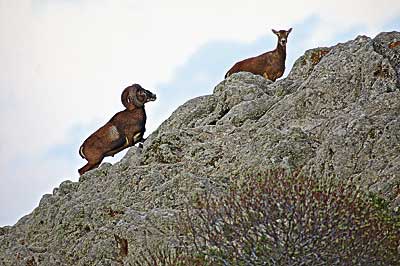
The breed has a notable inclination to be sociable and tends to form groups, sometimes of considerable size. It is usually possible to find groups consisting of adult females with infant and young animals of both sexes, groups consisting primarily of males over two years old and mixed groups, very common during the mating season, which occurs in October or November. In this period, the adult males actively seek out females in heat by joining the female groups and try to get control of them, sometimes by fighting rivals of similar size. Combative behaviour between males can be intense and violent during the mating season; although there are actually norms of behaviour, with ritualised displays of aggression (a kick with the front foot and a turn of the head), two others often used are head butting with the horns and a running clash head-on. There is another method, though, by which the males tend to compete and that is to mate with a large number of females, outdoing their opponents in terms of fertility by producing a greater quantity of sperm. This phenomenon, termed spermatic competition, leads the males to compete for fathering the young on the basis, not only of access to the female but also of the adequacy of their output of reproductive cells.
Births take place between March and May, depending on local climatic factors; the females normally look for safe places to deliver their young and to spend the early days after the birth. This lasts for the youngster’s first two months of life, forcing the mothers to make moves of greater magnitude than the adult females that have no young. Mothers and their young communicate by bleating, which acts as a means of contact and reduces in frequency from autumn onwards.
In the Alps, the mouflons find the weather conditions the most limiting factor; snowfalls in late Winter and Spring have a heavy impact, especially on the survival of the lambs. The Golden Eagle and the wolf are always able to prey on the young. Females with young can take very effective defensive measures against wolves. The Northern Apennine Wolf has shown itself to be an effective predator of this breed in particular in areas where the existence of refuges is limited. Finally, stray dogs can be a danger for this breed, especially following heavy snowfalls.
|
